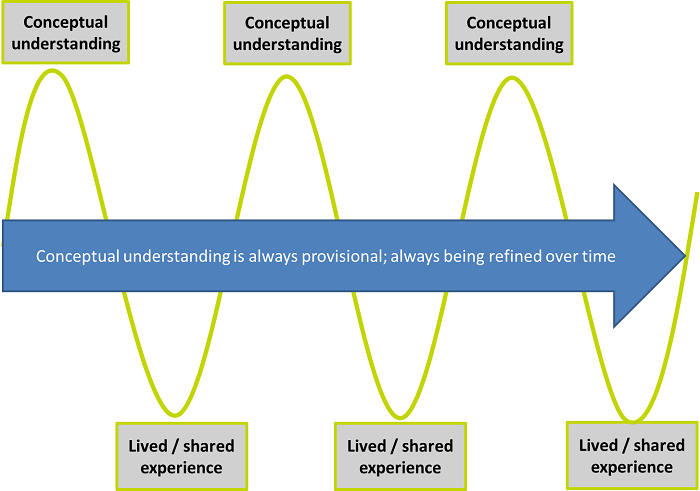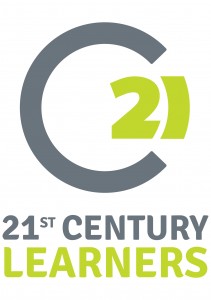Drawing Children into Cultural Dialogues with P4C

‘What then is time? If no one asks me, I know what it is. If I wish to explain it to him who asks, I do not know.’ St Augustine
“When you are a Bear of Very Little Brain, and you think of Things, you find sometimes that a Thing which seemed very Thingish inside you is quite different when it gets out into the open and has other people looking at it.” Winnie the Pooh
During a recent Philosophy for Children (P4C) enquiry our starting point was the question ‘When does a conflict go too far for forgiveness?’ As we considered the meaning of ‘forgiveness’ the problematic nature of the term soon became clear. Reflecting on the enquiry, one participant said “When we started the question seemed straightforward, but now I’m not even sure what forgiveness is!”
Philosophers from St Augustine to Winnie the Pooh have had the same feeling. But why might this feeling be educationally valuable? How can we justify spending an hour of children’s time raising and discussing such a question only to lead them into a state of confusion or, as the Greeks would have it, aporia? And can such a discussion have any real value if it is not informed by some of ‘the best that has been thought and said‘ about forgiveness?
I believe that the discussion has both intrinsic educational value and value as a gateway to a wider dialogue with the best that has been thought and said, and in what follows I will try to share the reasons underpinning this belief.
Children come to enquiries such as the one described above with their own perspectives on concepts such as forgiveness. These might not be consistent with dictionary definitions or with the perspectives of different faiths, but they are not invalid. They are forged in the fire of lived experience and given meaning through action and reflection on action. They deserve to be heard without being hastily judged – to be valued and responded to. They also deserve to be brought into creative tension with other perspectives and so strengthened or altered.
As children come to understand the value of engaging with other perspectives, and the value of sharing their own, they are being drawn into dialogue. Teaching children how to engage in dialogue is, in my view, a profoundly educational act in its own right, as I have argued elsewhere. It might also be argued that the dialogic thinking skills developed through the regular practice of shared enquiry are,despite vociferous arguments to the contrary, transferable to the wider curriculum (see this post). P4C explicitly sets out to teach children how to get better at dialogue using a flexible framework of ground rules known as the 4Cs. It also develops children’s understanding of concepts that are central to their lives and supports them to make better judgements (to be more wise). Herein lies the intrinsic value.
But the dialogue doesn’t need to end with the P4C session. The induced state of aporia may remain; once a child (person) realises that his or her own perspective is limited, incomplete, provisional, once his or her curiosity has been awakened, he or she will continue to seek out and grapple with new perspectives, internally as well as externally. This is the opening of a door that may never close, or, in the words of Professor Rupert Wegerif, the opening of dialogic space.
We might imagine that on the other side of this door waits the teacher. Teaching is most likely to be successful when the student is open to being taught. Once the door is ajar, the student may be drawn through it and on into a wider dialogue with the many things of enduring value that have been said (about forgiveness, in this case). This is a process of widening (bringing in new and different perspectives) and deepening (examining our existing beliefs more critically), and can perhaps be achieved by a variety of pedagogical approaches, including those that might be regarded as ‘traditional’.
However, it is easy to inadvertently ‘close the door’ on the dialogue (or close the dialogic space). We might do this if we convey the message that there is one true perspective (on forgiveness) that is fixed for all time. Why would one continue to seek out fresh perspectives if only one is given authority? Why would one need to find one’s own voice if all that is of value has been said already? The best that has been thought and said is of great value, but it is unfinished…
And if, as we explore the best that our culture has to offer, we lose the connection to the children’s lived experience we may again close the door on their opportunity to make meaning. Meaning is made through reflection on experience; richer meaning can be made in the shared space of dialogue. Having acted as an archway to enduring cultural ideas, P4C (or other dialogic / dialectical approaches) may still have a role in bringing the child’s voice back into the conversation.
During a discussion about her own research interests (to be published in due course), my colleague Diane Swift, Director of the Keele and North Staffordshire Primary SCITT (KNSPS) gave me the idea of representing this process as a cycle, or wave:

Here the peaks of the wave represent the children’s abstract or conceptual understanding of powerful ideas, like forgiveness (or indeed mathematical proof or chemical equilibrium), that help us to make sense of life (or of academic subjects). The troughs represent the concrete, lived experience of the children, and the shared experience of their learning in school. The conceptual understanding is, through the medium of dialogue, tested and refined against the new experiences, new perspectives, and new learning and it evolves over time. This image might represent a single conversation, or it might represent a much longer period of time with the crests being separated by years of experience and learning during a child’s lifetime, or by decades and centuries in the much greater dialogue of humanity.
Of course this metaphor runs the risk of representing linear progress towards an ultimate truth – things are always a good deal messier than that. But the key thing is to understand that conceptual understandings are always provisional. We need to learn about the best that has been thought and said – the conversation so far – but we should also know that there is always more to say, and that what we have to say during our lifetimes is a valuable part of a great and ongoing dialogue. P4C and related approaches have a valuable role to play in keeping such dialogues open for our children.
Acknowledgements
As ever, my thoughts here draw heavily on dialogues with others, most notably Professor Rupert Wegerif of Exeter University and Diane Swift of Keele and North Staffordshire Primary SCITT.



April 10th, 2017 at 15:06
Very nice blog. I think that there is progress towards truth. I agree it is not linear. One way to understand why this progress can’t be linear is to think about progress in a dialogue more generally. It may that the next utterance adds a little knowledge to the thread of what has been said so far or it maybe that it re-interprets it completely. Sometimes these reinterpretations make everything that has gone before seem irrelevant and mean that we need a new start. The Copernican revolution was a bit like that in relation to working out the orbits of planets. Or Einstein’s re-thinking of gravity as a topographic feature rather than a fixed force.
But what about the end of all this progress? Things hang together so much that it is not really possible to understand any one thing perfectly unless you understand everything. But ultimate knowledge could not really be knowledge of any kind of thing at all because knowledge of things implies a separation, a standing out side and looking at the thing, whereas knowledge of everything would have to include the consciousness of the knower. The final step in the journey, or the final utterance in the dialogue of knowledge, would require a radical reinterpretation of what we mean by knowledge. Merleau-Ponty put this, in relation to the idea of the Totality, as: ‘what there is to be grasped is a dispossession.’
But the lack of an end point does not mean that there is no progress. Amartya Sen points out that even if there is no perfectly just or good state we can still know that some things are better than others – or some laws more just than others. In the same way I think that knowledge is always relative to a situation. We know that some things work better than others. That is progress. To know everything is not possible in the sense that it would imply not having a situation. So paradoxically, even though there is no grand ‘Theory of Everything’ there is still progress that feels as if it is progress towards such a grand theory.
April 10th, 2017 at 20:17
Thank you, Rupert. I think my idea of ‘messy’ progress also encompassed the thought that dialogues might sometimes go down unproductive avenues and take some time to find their way back, but, as you point out with your example of Lamarck, even these contributions help the overall ‘progress’.
April 11th, 2017 at 11:50
Good point. Nikulin, D. (2010. Dialectic and dialogue. Stanford: Stanford University Press. ) makes the open and uncertain nature of dialogue the main difference between Socrates’ dialogic and Plato’s dialectic. You cannot really know where a dialogue is going and if it is progressing until you look back and see how far you have come and decide to name that progress. Real dialogues are not only logical but also emotional and open to many contextual features that go beyond reason.
I argued, using the example of Lamark, that progress in dialogue is not just about explicit theories that are constructed but also about awareness of the options. As well as progress from A to B, from e.g Lamark to Darwin, you also get progress from A to A + B. From Lamark to Darwin + Lamark. Lamark was laughed at by the Darwinian’s but now appears in papers about epigenetics. His voice did not disappear. It remained in the dialogue to expand the space of possibilities. Science progresses not through induction (which is simply not possible accorded to Hume) but through abduction which requires creativity in putting forward theories to explain observations. That creativity depends upon the field of the possible. I speculate that the fact that Lamark’s voice remained in the dialogue, albeit in a suppressed state, helped in the formulation of new theory in epigenetics. This kind of progress as expansion of awareness of the range of possibilities, or the number of different voices in the dialogue, is especially important when the issue is not about explicit theories but about understanding other people. In interfaith dialogue, for example, progress in insight and understanding is often reported even when there are no explicit or recordable changes in actual views. You can see this idea of progress through expanded awareness in an extreme form in T.S.Eliots’ line: ‘the end of all our exploring will be to arrive where we started and know the place for the first time’ Often what we see now is from the point of view of utility, only relative to our needs, but perhaps to see things more fully is to see them from all possible points of view. Of course to see from ‘all possible points of view’ is not really possible. But if it were possible that would perhaps be a better idea of what a ‘Theory of Everything’ would be like than the idea of an explicit scientific formula.
April 11th, 2017 at 19:50
Thank you for the reference – I think the tension between dialogue and dialectic is one that I would like to explore further. The value you attach to ‘expanded awareness’ brings to mind Bohm’s appeal to us to ‘suspend’ judgement / assumptions and give ourselves time to look at the other. Perhaps this is in some way important in the teacher-student relationship too, as it helps us to genuinely value the student’s perspective.